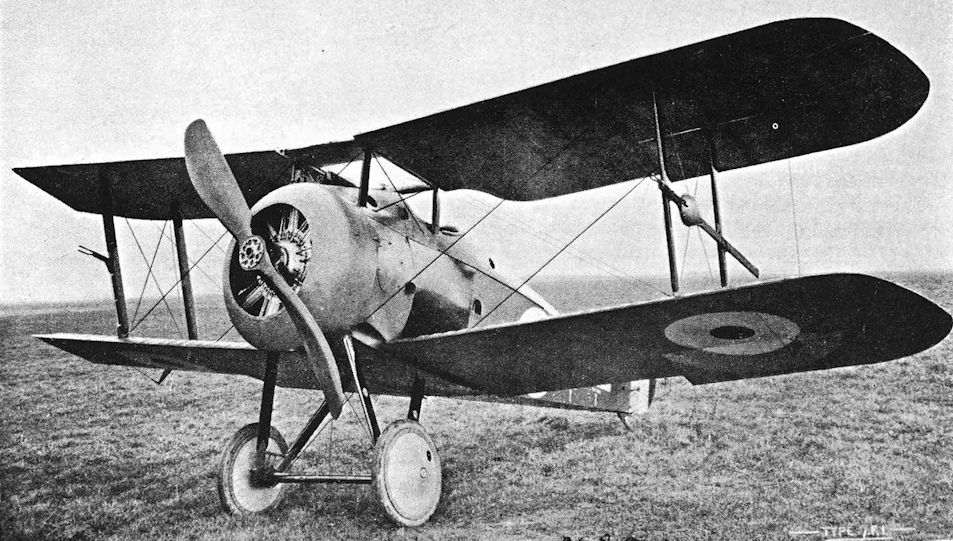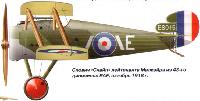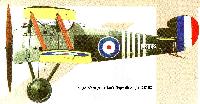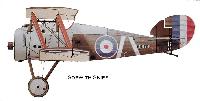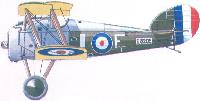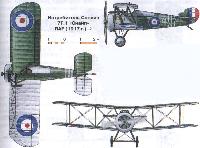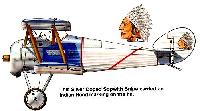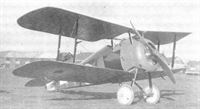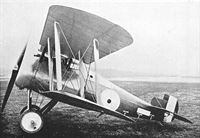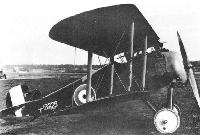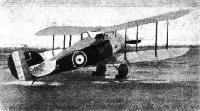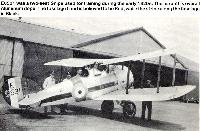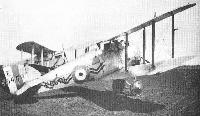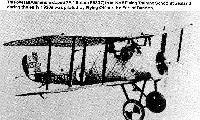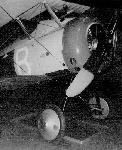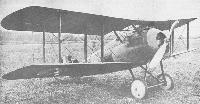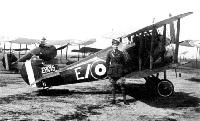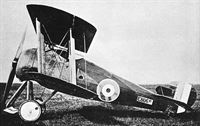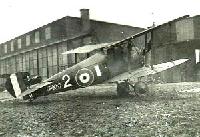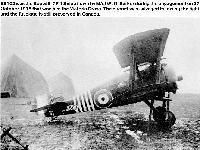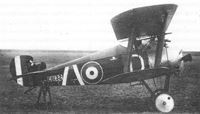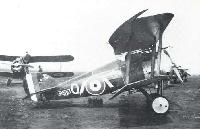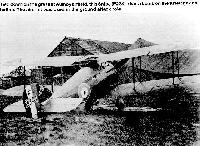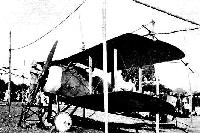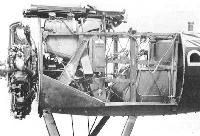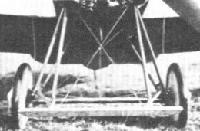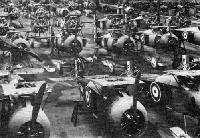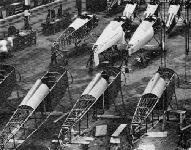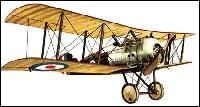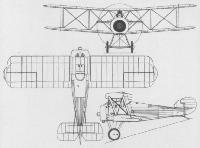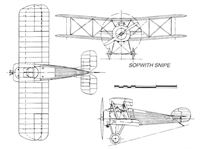В.Кондратьев Самолеты первой мировой войны
Сопвич 7F.1 "Снайп" / Sopwith 7F.1 Snipe
Цельнодеревянный двухстоечный биплан с полотняной обшивкой. Разработан в КБ фирмы "Сопвич" как адаптация истребителя "Кэмел" под новый мотор "Бентли" BR.2 мощностью 230 л.с. Помимо двигателя, самолет отличался увеличенным размахом крыла и усиленной конструкцией планера.
Первый прототип появился в конце 1917 года, однако, из-за недоведенности "штатного" мотора, на нем установили 150-сильный BR.1, такой же, как на "Кэмеле". Аналогичным было и вооружение - два синхронных "виккерса".
В марте 1918-го с фирмой "Сопвич" заключили контракт на поставку 1700 истребителей, получивших название "Снайп" (Snipe - бекас). Первые серийные машины с моторами BR.2 начали выходить из заводских цехов в июле, а в сентябре первая авиачасть, укомплектованная "снайпами" (43-й дивизион RAF), прибыла на западный фронт.
Самолет обладал, по сравнению с "Кэмелом", улучшенными летными данными, однако, несмотря на гораздо более высокую энерговооруженность, прирост оказался весьма незначительным. Более существенному повышению характеристик мешала не очень удачная аэродинамика машины. И тем не менее, "Снайп" считается лучшим английским истребителем времен Первой мировой войны.
До перемирия успели построить 497 "снайпов" и перевооружить ими три английских и один австралийский дивизион. Самолет выпускался до конца марта 1919 года (всего построено 1567 штук) и состоял на вооружении RAF до 1924-го.
После войны 12 "Снайпов" было продано в Бразилию, четыре - в Канаду. Еще 15 штук весной 1919-го отправили на север России в составе британских интервенционистских сил. Их включили в состав "Славяно-британского авиакорпуса". Почти все эти машины в течение года были списаны в результате аварий и катастроф, а последняя в марте 1920 года захвачена красными при взятии Архангельска и включена в состав РККВФ.
ДВИГАТЕЛЬ: "Бентли" BR2, 230 л.с.
ВООРУЖЕНИЕ:
Стрелковое: 2 х 7,7-мм синхронных пулемета "Виккерс"
Бомбовое: 4 бомбы по 9 кг.
ЛЕТНО-ТЕХНИЧЕСКИЕ ХАРАКТЕРИСТИКИ
Размах, м 9,14
Длина, м 5,80
Высота 2,92
Площадь крыла, кв.м 23,80
Сухой вес, кг 592
Взлетный вес, кг 911
Двигатель: "Бентли" ВР-2
мощность, л. с. 230
Скорость максимальная, км/ч 195
Скорость подъема на высоту
3000 м, мин. сек 9,20
Дальность полета, км 480
Потолок, м 6000
Экипаж, чел. 1
Показать полностью
А.Шепс Самолеты Первой мировой войны. Страны Антанты
Сопвич "Снайп" (Snipe) 1917 г.
Одним из лучших истребителей Первой мировой войны с ротативным двигателем стал самолет фирмы "Сопвич" - 7F.1 "Снайп". От предыдущих машин он отличался многими конструктивными особенностями. Эта машина - двухстоечный биплан с фюзеляжем типа полумонокок смешанной конструкции, в которой вместе с деревом стали применяться металлические трубы и профили. Обтяжка осталась полотняной. Капот двигателя аналогичный "Кэмл". Крыло большего размаха имело дополнительную пару стоек, двухлонжеронное, подобное по конструкции крылу "Кэмл", также оборудованное элеронами. На самолете установлен 9-цилиндровый, воздушного охлаждения, ротативный, звездообразный двигатель "Бентли" BP-2 мощностью 230 л. с.
Хвостовое оперение подобно оперению машин типа "Кэмл". Стабилизатор с регулируемым углом установки. Вертикальное оперение с небольшим килем. Руль поворота с роговой компенсацией.
Управление самолетом тросовое, осуществлялось от ручки управления и педалей, обычное для машин того времени.
Шасси аналогичное применявшемуся на более ранних самолетах фирмы.
Прототип с двигателем "Клерже-9b" (150 л. с.) испытан летом 1917 года, но мощность двигателя уже была недостаточной, и в декабре на машину установили более мощный двигатель - "Бентли" BP-2, с которым машина пошла в серию. Она оказалась очень удачной и состояла на вооружении до 1927 года.
Кроме этого, в 1918 году фирма "Сопвич Авиэйшн Компани" строила небольшими сериями истребители "Саламандер" (двухстоечный биплан с фюзеляжем прямоугольного сечения и фанерной обшивкой, в остальном аналогичный истребителю "Снайп").
В 1916-1917 годах участились налеты немецких дирижаблей и тяжелых бомбардировщиков на Великобританию. Бомбардировка проводилась с высот более 4000 м, на которых маневренность существовавших истребителей была недостаточной для ведения маневренного боя. К тому же радиус их действия был невелик. Для организации перехвата над Ла Маншем германских бомбардировщиков и цеппелинов проводились опыты с подвеской истребителей "Кэмл" на дирижабли. Доставленный таким образом в район Ла Манша самолет при обнаружении самолета и дирижабля противника отцеплялся от трапеции и, атаковав врага, возвращался на свой аэродром.
Показать полностью
H.King Sopwith Aircraft 1912-1920 (Putnam)
7F.1 Snipe
First constructed - specifically as a successor to the Camel - late in 1917, the Snipe was destined to remain in service with the RAF until 1926, even though the Sopwith company had gone into voluntary liquidation in 1920. The operational history of the Snipe, therefore, is largely 'post-Sopwith', and somewhat obscured by the fact that the first Hawker Woodcocks were replacing Snipes in May 1925 (the Woodcock having first been flown in 1923). Harry Hawker, whose surname the new company bore, had been killed in the Nieuport Goshawk in July 1921. That same aeroplane (the Goshawk) was the precursor of the famous Gloster racer nicknamed 'Bamel, though, unlike the Snipe, the Bamel was not related to the Camel - its hump containing nothing more lethal than fuel!
There is one further point to make here: Both the Goshawk and the Bamel belonged to the Nieuport Nighthawk family - and so, also, did the Nightjar, which saw RAF service as a Naval fighter and was a direct counterpart of the Snipe, having the B.R.2 rotary engine; in being rigged as a two-bay biplane; and in being fitted in one form - called Sparrowhawk III - with a hydrovane landing gear (plus the normal wheels) similar to that which was tried on the Snipe when that Sopwith fighter was itself envisaged as a replacement for the 2F.1 (Ship's) Camel.
While the Snipe's record of RAF service as generally published has rightly surveyed developments after Maj. W. G. Barker's monumental Fokker-fight of 27 October, 1918, by naming Home Defence duties jointly with commitments in occupied Germany, Russia, Egypt, Turkey, India and Iraq, and has given due credit to the Snipe as a trainer as well as a Hendon highlight (formation aerobatics in 1921, for instance) one aspect of this Sopwith fighter's use seems nevertheless neglected. This particular aspect was not, perhaps, of great importance; but - having gloomy regard to circumstances that prevail in Ireland at the time of writing (as of yore) - it has indubitable interest, and helps to place the Snipe in true perspective.
Here one has in mind the employment of RAF Snipes in 1921, when 'Snipes for the Snipers' was an item in the news - though 'snipe' instead of 'for' might have been more explicit, having regard to the explanation: 'A patrol of this type of aeroplane recently located [in Ireland] an ambush, and the result was disastrous for the ambushers, five of whom were killed by our airmen.'
Another point concerning the Snipe's lengthy retention in RAF service is that this was not solely due to economic considerations, but also to difficulties with the A.B.C. Dragonfly radial engine (See later chapter headed 'Dragon').
Thus, while Woodcocks, Siskins, Grebes and Gamecocks took up their stations, it was in large degree the Snipe - both by its physical presence around the RAF and by artless representations in official publications on fighting tactics and airmanship - which was to nurture many leaders for the '40s and the '50s and beyond. (Quite often - very long after the Armistice - was the Snipe depicted in various attitudes and in varying company, some members of the latter having a distinct resemblance to L.V.G.s or Rumplers; and such was the colouring of the Snipe and its consorts in those 'tween-war years that pilots were counselled how, in stalking an enemy, they should not bank so steeply that sunlight might flash 'from planes or struts'. They should watch, moreover, an adversary's rudder, because its movement could foretell the direction of a turn). In such an environment - linking the First World War quite directly with the 1930s - the Snipe eked out its presence in the RAF; and even Hawker Fury pilots were to see its presence in their printed guides.
All of which seems far removed from the first ideas of the Snipe, as they grew - generally conforming to the Air Board A.1(a) specification, then already some months old - in the summer of 1917. Six examples (B9962-B9967) were ordered for experimental and development flying, and the first of these was a very different aeroplane from the Snipe so well remembered by so many pilots. This difference was chiefly by reason of the short-span - 25 ft 9 in (7.9 m) - single-bay wings; the flat-sided fuselage behind the rounded engine-fairings; and the Camel-type tail. Camel-reminiscent also was the 150 hp Bentley B.R.1 engine. The top centre section was somewhat cut back at the leading edge; was open between the spars; and was carried on near-vertical struts. Main-panel root cut-outs on the top wings were prominent, though differing in shape from those at one time schemed. In sum, this was one of the trimmest, most compact, and most aggressive-looking fighters ever built, affording a clearer view for the pilot than the Camel and - hopefully, it may be surmised (from the equal dihedral, for instance) - restoring some of the Pup's tractability.
The next version (conceivably a rebuild of the first machine) was seemingly almost identical, though having a B.R.2 engine of 230 hp and also the increased dihedral applied at some stage to the first. In any case, this first B.R.2 version (and the B.R.2 was to become well-nigh identified with the Snipe) was numbered B9963 - and on 23 November, 1917, it was at the Royal Aircraft Factory, Farnborough.
Chiefly for a report on the B.R.2 engine, a single-bay Snipe (confusingly logged officially as '9965') was intended to go to Martlesham Heath, after crashing at Brooklands on 19 November, 1917, and being repaired at Kingston. It did in fact arrive at Martlesham a month later (18 December), and there it was briefly tested (before another mishap) without ammunition, attaining a speed of 119 mph (192 km h) at 15.000 ft (4.570 m) - a height to which it climbed in 14.8 min. As the level at which the speed-run mentioned was made seems uncommonly high, and the B.R.2 was not supercharged, it may be explained that the experimental unit fitted was not run at full throttle below 5,000 ft (1.524 m).
Snipe B9965 in early form appears to have had not only single-bay wings but a wider centre section, with splayed-out struts; faired (rounded) fuselage sides; and vertical tail-surfaces of new design (small fin, with angular horn-balance for rudder). Later the machine so numbered was given two-bay wings of greater span about 30 ft (9.1 m.) - on the uppermost whereof a Lewis gun was mounted (pivoted on the rear spar of the centre section) in addition to the two standard fuselage-mounted synchronised Vickers guns. Such alterations inevitably confuse any survey of the 'development' Snipes - a survey further blurred by the Snipe's near relationship to the Salamander; by rebuilds and structural-test specimens; and - not least - by the apparent initiation of the Snipe's construction as a private venture (under Licence No.14, whereby the Rhino triplane bomber was also built), with retrospective numbering of individual airframes not being decided or confirmed until November 1917. Contractural convenience, or even 'security', may have been considerations here.
In any case, one major consideration in the development programme was the chosen engine - the Bentley B.R.2, as already affirmed, becoming 'well-nigh identified with the Snipe', although in November 1917 the eleven-cylinder Clerget 11E, as installed in the Hippo and Bulldog two-seaters, was still envisaged as an alternative. (A Clerget of this type was eventually and temporarily installed in Snipe F2340, though seemingly in connection with the Salamander programme).
By February 1918, B9965, with two-bay wings and third (Lewis) gun though in other respects deficient in military equipment and even in rigging had been officially tested (B9966 not so, though this had been intended). Whatever criticisms may have been made of the Snipe by this time, however, the pilot's view was considered 'excellent' which was more than could be said of the Pup or the Camel. And here one would emphasise that by this time also field of view was deemed increasingly important not for combat alone but equally for systematic search.
By March 1918 the Snipe had been chosen for adoption rather than any of its direct competitors, the Austin Osprey triplane, the Nieuport B.N.1 unconventionally braced biplane and the Boulton & Paul Bobolink, which last-named almost merited the description just applied to the B.N.1. Factors in the choice were the well-established 'acceptance' of Sopwith types by the Services and manufacturers and the use of standardised Sopwith components; though in all frankness the Snipe did not illuminate the fighter scene with dazzling brilliance. However, B9965 went off to France, where the 23-year-old officer who was to become Air Chief Marshal Sir Leslie Hollinghurst, and who was to know Snipes well between the wars, made a few criticisms but (once again) praised field of view - as well as manoeuvrability. These same characteristics were stressed by other RFC pilots, though (like Hollinghurst) they remarked on tail-heaviness and recommended removal of the Lewis gun. That the rudder was too small was a general criticism, and that manoeuvrability was not, perhaps, one of the Snipe's stronger points after all, was suggested.
In any case, on 20 March, 1918, Snipes to a total of 1,700 were ordered from Sopwith themselves, Boulton & Paul, Coventry Ordnance Works (shades of young Tom's test-flying days!), Napier (not such a new name in the airframe, as distinct from engine, world as might be supposed), Nieuport & General, Portholme Aerodrome and Ruston Proctor.
Still B9965 continued as the chief test-specimen, and in May 1918 was returned to Sopwith to be given a new engine-cowling, jointly with a huge open-fronted spinner (a precursor of those on the Snapper, Cobham, post-war Schneider and Rainbow) with lower-segment holes in the cowling for the B.R.2's exhaust efflux. By the beginning of July this same Snipe was at Farnborough; but B9966 had been at Martlesham in May, with an adjustable tailplane (later standardised), larger fuel and oil capacity and a new fuel system (Badin type, with venturi tube on the starboard front centre-section strut, used to transfer petrol from the main tank under the pilot's seat to the gravity tank behind the engine). A mounting for a Lewis gun was retained, and a slightly bigger rudder fitted, though before October 1918 Snipe B9966 was at Martlesham with a new 'production-type' fin and rudder (large curved tin), a centre-section with inter-spar cut-out revised once again (there were several variations), and, most remarkable of all, an experimental tailplane/elevator assembly of puzzling complexity and near-triangular plan form, the rear part of the tailplane having variable incidence - all this together with horn-balanced ailerons (with inverse taper, like the elevators) on the top wings.
True production Snipes had nevertheless been under test since mid-August 1918 - and here an anomaly can be recorded, in that E7996 was with No. 43 Squadron at the Front on 13 August, whereas E7987 did not arrive at Martlesham until five days later. The term 'true production', furthermore, is open to misconstruction, for the first Snipes off the lines had plain ailerons and a small fin, though the larger fin, and rudder with shielded horn balance, as tried on B9966, together with horn-balanced ailerons on the top wings, soon became standard fitments (not, however, the 'fancy' horizontal tail surfaces!).
Even so, our earlier appraisal of the Snipe that it 'did not illuminate the fighter scene with any brilliance' - remained valid, special engine-tuning and other recourses notwithstanding.
On 24 September, 1918, No. 43 Squadron (the first to be Snipe-equipped) could put up fourteen of the new Sopwiths, and by 31 October there were 97 Snipes in France, three squadrons being equipped by the Armistice. Of all these early-production Snipes the most famous was E8102, wherein Maj W. G. Barker won his Victoria Cross on 27 October, 1918, in an action hardly less worthy of renown than the last fight of Sir Richard Grenville's Revenge or the Charge of the Light Brigade. Alas, there was no Tennyson to commemorate the glory of a solitary Snipe against fifteen Fokkers, and John Masefield was sticking to his beloved ships.
Nevertheless, we now retell in essence the stirring tale of Barker's action in E8102:
Major Barker, who was on a refresher course from England with No. 201 Squadron, RAF, while on patrol in this Sopwith-built Snipe attacked an enemy two-seater at 21.000 ft over the Foret de Mormal, and the E.A. broke up in the air. He was then fired at from below and wounded by a Fokker biplane, and fell into a spin, from which he pulled out in the middle of a formation of fifteen Fokkers, two of which he attacked indecisively. He then got on the tail of a third, which he shot down in flames from a range often yards. He was again wounded, and fainted, but on recovering he regained control of his Snipe and was attacked by a large formation of E.A., one of which he shot down in flames from close range. He was then hit in the left elbow, which was shattered, and again he fainted, the Snipe falling to 12,000 ft before he recovered. Another large formation then attacked him and, noticing heavy smoke coming from his machine, Barker believed it to be on fire, so he tried to ram a Fokker. He opened fire on it from close range, and the E.A. fell in flames. Finding his retreat cut off by eight of the enemy, at which he fired a few bursts and succeeded in shaking them off, Barker returned to our lines a few feet from the ground, finally crashing near our balloons.
During the latter part of this combat Barker was without the use of both legs and one arm.
Thus the analogy of the Revenge (‘the one and the fifty-three') is surely a fitting one; and with the sea now in mind it must not go unrecorded that, but for the ending of the war, Snipes would have been in Naval service. By October 1918, E8068 had, in fact, been fitted with a hydrovane ahead of the jettisonable wheels to render ditching less risky and, if nothing else, tests showed that the speed-reduction with the hydrovane was only 3 mph (5 km/h). Slinging gear, for salvage from the sea, was another feature that had to be developed for the 'Ship's Snipe", though arrester-hooks for deck-landing were seemingly not developed for the Snipe until 1923/24 - the comparable Nieuport Nightjar then being already in service.
For Home Defence the Snipe was just beginning to enter the service stage as the war finished; one Camel squadron, indeed, would have been re-equipped in January 1919 and by March of that year five would have had the new and larger Sopwith single-seater. In this Home Defence context especially it may be noted that, having its two-bay wings of greater area, and also the lifting power of some 230 hp, the Snipe could carry a warload that might involve relatively elaborate night-flying equipment - including, for example, navigation lights. Holt electrically ignited wingtip flares, and a wind-driven generator on the front starboard landing-gear strut - in addition to two Vickers guns with a greater ammunition supply than a Camel's (with provision also, on some aircraft, for an optional Lewis gun on the top wing). Wireless, 'safety' or self-sealing petrol tanks, oxygen equipment, ply-covered leading edges for the wings and special finishes were all investigated and used in varying degrees and at various stages; and E8137 at least was adapted to take a Calthrop Guardian Angel parachute. One clearly visible item that distinguished standard production Snipes from the experimental models was the steel-tube (instead of wooden) landing gear, and in postwar years the Badin fuel system (using a venturi) was sometimes replaced by a wind-driven pump mounted under the fuselage near the rearmost pair of steel-tube struts.
Respecting fuel supply, however, by far the most interesting development was the increased tankage for the Mk.Ia 'long distance' Snipe (Mk.I was a retrospective designation for the standard type, and, indeed, the name Snipe had not been officially adopted until February 1918). The Mk.Ia was becoming available at the end of 1918, its chief distinction being the fitting of a special main tank - of 50 gal (227 litre) capacity instead of 32 gal (145 litres) behind and beneath the pilot's seat, the rearward movement of the centre of gravity being compensated by a very slight sweep-back of the wings, some components of which (like some fuselage members) were strengthened. Snipe E8089 was the first to be converted to something approaching the ‘long distance' standard, though its Dolphin tail unit was not perpetuated. This particular Snipe was on test at Martlesham Heath in October 1918; but handling was poor, and although 'long distance' Snipes went overseas, the Ia sub-type was never truly operational. In any case, with the machine virtually non-aerobatic at heavy loadings, and 'straightforward' flying only being foreseen, one may speculate on its bomb-carrying propensities, even with the normal Camel/Snipe loads of 4 x 20 lb or 1 x 112 lb. An 'escort fighter' inhibited from fighting in defence of bombers might at least help them with the bombing.
From the purely technical, as distinct from operational, aspect the most significant development was the adaptation of Snipe B9967 (the last of the original six that had been ordered, as already recorded, for experimental and development flying) to take the A.B.C. Dragonfly nine-cylinder air-cooled radial engine of well over 300 hp. This 'Dragonfly Snipe' had been completed as early as April 1918, and though the early-pattern small fin and rudder was retained (as originally fitted on B9966) the fuselage was lengthened by 1 ft 10 in (0.6 m) to give the longer lever-arm necessitated by the greater side-area of the new radial. Though the Dragonfly was very closely cowled (the crankcase and inter-cylinder cowling being in one piece, and cable-secured in Sopwith style) the cylinder heads were exposed. Such was the importance (as then judged) of this new powerplant installation that in October 1918 the name Dragon was officially adopted.
Less significant (being in a tradition established by the Camel) was the trainer version of the standard Bentley-engined Snipe, a two-seater wherein there were cockpit variations (notably in width), though Sopwith's own design of late 1918 or early 1919 provided for the second cockpit to be immediately behind the standard cockpit of the single-seater. Postwar RAF Snipe fighter squadrons usually had at least one, and sometimes two, of these instructional Snipes, and the type was still serving at Flying Training Schools after the fighter Snipes had gone in 1926. Here, however, the Sopwith part of the Snipe story reaches some degree of finality, for the Hawker company was certainly converting Snipes to two-seaters (as well as reconditioning single-seaters) by early 1922.
The handling of the Snipe was generally good, though it always had the reputation for being heavy laterally - in which connection observe that in the following excerpts from the Handling Notes (which are evocative as well as educational) there is a special warning that 'lateral control is heavier than on the Avro'. Thus a few sequential fragments:
'Petrol taps must be turned on. The throttle should be fully opened and the fine adjustment opened about one-third of the quadrant. Mechanics must close the air intake pipes by holding their hands over them. After sucking in, the fine adjustment should be closed, leaving the throttle lever one-quarter open. When both switches have been switched on and the engine first fires, the fine adjustment should be opened slowly until smooth running is obtained at about 600 r.p.m. or slower for about half a minute. This should be continued until the oil can be seen moving in the pulsometer glass ...
'The Snipe taxies steadily, but no attempt should be made to turn in a strong wind without the assistance of mechanics on the wing-tips. When the aeroplane is being taxied, the engine should not be run on the switch. The tailplane lever should be in the half-way position. A slight forward pressure on the control column is necessary to lift the tail off the ground. The Snipe will take herself off after a short run at a flying speed of 50 m.p.h.
'An average cruising speed of about 90 m.p.h. can be maintained with the engine throttled back to 1,000 r.p.m. At low altitudes, a considerably greater flying speed can be attained without strain, provided the engine does not exceed its maximum r.p.m.
'The best climbing speed is about 65 m.p.h. The bottom of the front centre-section struts are just above the horizon. The tailplane should be adjusted so that the aeroplane climbs "hands off".
'The Snipe has a good steady dive but gathers speed rather quickly. The pilot should set forward the tailplane adjustment lever when diving, and should use it when coming out of a dive.
'The lateral control is heavier than on the Avro. On a turn to port, the nose has a tendency to go up, and a lot of bottom rudder is required to keep the nose on the horizon. In a steep turn to port, the control column should be pulled back slightly; if it is pulled right back, the aeroplane will stall and spin. In a turn to starboard, the nose has a tendency to go down. Top rudder is therefore necessary, and the control column may be pulled right back. For quick turns, the tail lever should be set right back.
'When the Snipe is being glided, the tailplane adjustment lever should be set right back. The normal gliding speed is 65 m.p.h. ...'
In no action were the Snipe's fighting qualities more apparent than in Barker's 'scrap' with the Fokkers in October 1918; but this must not obscure the fine work done on the type by Australians - an interesting reflection and connection here between this present chapter and that to follow on the Dove. Barker was a Canadian, and in Ottawa today may be seen the fuselage of E8102 the most honoured survival from 1,550 Snipes completed. Canada had a few other Snipes (as had the USA) and the French evaluated a Snipe in 1918, though whether there is any link here with a Dragonfly engine being sent to France is unsure.
Five Snipes only passed to the British Civil Register, one of these, G-EATF (ex J365) being used apparently without great success-as a demonstrator by the Aircraft Disposal Co. The others were G-EAUU (J459), G-EAUV (J453), G-EAUW (J455) and G-EBBE (J461) - this last specimen having been delivered to the Belgian Air Force in January 1922. An all-British 'Tally-ho' was the participation in the 1920 Aerial Derby (the Dragonfly-engined Sopwith Rainbow also) of 'UU, 'UV and 'UW, though hardly less British and sporting - even though on behalf of US movies - was the purchase of Snipes by film-star Reginald Denny, for Denny played parts as 'true-British' as the Snipe itself.
One recurrent question concerning the Snipe, and to which an answer may be attempted, is why the type should have been used by the RAF instead of the Martinsyde Buzzard, with its much higher performance. One possible answer (apart, of course, from availability of airframes) could have involved the preferred engine for the Martinsyde - a French Hispano-Suiza; another could have been wing flutter - a phenomenon that became increasingly apparent on RAF fighters after the Armistice.
Production orders for Snipes were:
Sopwith B9962- B9967; E7987 -E8286; F2333- F2532; F7001-F7030 (some at least with Dragonfly engine); H4865-H5063 (last contract not completed).
Boulton & Paul E6137-E6536; J451- J550 (most of second batch probably not delivered).
Coventry Ordnance Works E6537- E6686; F9846-F9995 (second batch possibly cancelled).
Kingsbury J6493-J6522
March, Jones & Cribb J301-J400; J681- J730.
Napier E6787-E6936.
Nieuport & General E6937-E7036.
Portholme Aerodrome E8307-E8406; H8663-H8762 (second batch probably not delivered, but some Ruston Proctor airframes were completed by Portholme Aerodrome).
Ruston Proctor E7337-E7836; H351- H650 (some of second batch probably not delivered).
N.B. Several other Snipe contracts were cancelled, or changed for Sopwith Dragons or Nieuport Nighthawks.
7F.1 Snipe (typical production) (230 hp Bentley B.R.2)
Span (over horn-balanced ailerons) 31 ft I in (9.5 m); length 19 ft 2 in (5.8 m); wing area 274 sq ft (25.5 sq m). Empty weight 1,305 lb (592 kg): maximum weight 2,015 lb (914 kg). Maximum speed at 10.000 ft (3.050 m) 121 mph (195 km/h); maximum speed at 15,000 ft (4,570 m) 113 mph (182 km/h); maximum speed at 16,500 ft (5,030 m) 108.5 mph (174 km/h); climb to 10,000 ft (3.050 m) 9 min 25 sec; climb to 15,000 ft (4,570 m) 18 min 50 sec; service ceiling 20,000 ft (6,095 m); endurance 3 hr (Snipe Ia 4 1/2 hr).
Показать полностью
P.Lewis The British Fighter since 1912 (Putnam)
Development of new, improved fighter designs continued at even greater speed and 1918 brought forth a number of machines of advanced design and increased performance. Of the aircraft actually built or merely considered as projects during this period there was not one which could be classed as an impractical freak. Indeed, all of them demonstrated plainly a sensible, rational approach to the design of single- and two-seat fighters, exemplified by an overwhelming predominance of the single-engine tractor biplane of refined form. Designers had obviously appreciated that therein lay the formula for success in the art of fighter design for the present and the immediate future. Although the final year of the 1914-18 War was notable for such an inspiring selection of prototype fighters only one, the Sopwith Snipe, was to be adopted for service in the R.A.F. in quantity. Even so, relatively few Snipes had been delivered to operational units in France by the end of the War and the main burden of aerial fighting continued to be borne until the Armistice by other fighters already in service.
The Sopwith 7F.1 Snipe grew out of a requirement for a new single-seat fighter to take the fullest advantage of the 230 h.p. developed by the Bentley B.R.2 rotary engine. The prototype flew first on the power of the 150 h.p. Bentley B.R.1 engine until a B.R.2 was delivered for it, the machine’s airframe using single-bay wings fitted to a flat-sided fuselage. A second prototype was constructed with curved fairings added to the sides of the fuselage, redesigned fin and rudder and other modifications. Conclusions formed following its tests in December, 1917, resulted in the appearance in January, 1918, of a third prototype, this time with two-bay wings of extended span. The Snipe’s excellent climb and general manoeuvrability and its lack of the trickiness which had characterized the Camel brought general approval of its selection as the R.A.F.’s new single-seat fighter. Further minor alterations were made in the airframe to improve the machine’s all-round qualities and its armament was standardized as two Vickers guns in the front decking. A long-range variant of the Snipe was designated 7F.1a and one was used to flight-test the 320 h.p. A.B.C. Dragonfly radial engine, with which it reached a speed of 156 m.p.h. The Sopwith Snipe is notable as being considered the best all-round single-seat fighter in operation by the Allies at the time of the Armistice and was to remain in R.A.F. service for some eight years.
Показать полностью
F.Mason The British Fighter since 1912 (Putnam)
Sopwith Snipe
The opinion, frequently expressed, that the Sopwith Snipe was ‘the best British fighter’ to be produced during the First World War, needs careful qualification. It was certainly the most highly developed Sopwith fighter to reach combat status before the Armistice. It did not, however, possess the best performance among British fighters in service at that time, although it inherited the superb manoeuvrability of the Camel, the aircraft it was designed to replace. Moreover that manoeuvrability was achieved with more tolerance of control mishandling than was the case in the Camel.
The extravagant claims for the Snipe were probably to some extent made on account of the isolated instances of outstanding combat success - not least that in which Maj W G Barker won the Victoria Cross only fifteen days before the Armistice. Furthermore, the fact that the decision to adopt the Snipe as the RAF’s standard single-seat fighter during the years immediately following the coming of peace suggested that it was the best available. The reasoning that lay behind this decision was that relatively large numbers of Snipes had been stockpiled during the last six months of the War, and that many of the planned manufacturers wished to opt out of the aircraft industry on the coming of peace. Sopwith itself occupied extensive factory space in Kingston and was apparently well staffed to continue with aircraft production in the long term. (It could not be foreseen that, within two years of the War’s end, T O M Sopwith would face crippling tax demands on War Profits and be forced into voluntary liquidation, nor that his pilot and close colleague, Harry Hawker, would step in to save the Canbury Park Road offices and shops with the formation of the H G Hawker Engineering Company. Although Hawker was to lose his life in the same year that his company was formed, that company was to return to the aircraft industry through the revenue earned from repairing and rebuilding Snipes for the RAF in the early 1920s.)
Be that as it may, the Snipe was an excellent and highly adaptable fighter which shouldered a difficult task during the RAF’s transition from war to peace. It should not be forgotten that an extremely high proportion of the RAF’s fighter pilots had served on at least one of Sopwith’s wartime aircraft, and many of these pilots had hopes of being granted commisions in the Service after the War.
The Snipe’s origin lay in the Air Board’s decision to proceed with support for an enlarged version of W O Bentley’s B.R.1 rotary, which had been successfully matched with the Camel. Bentley’s new engine, which retained the aluminium alloy cylinders with steel liners, was increased in bore and stroke, so that its capacity increased from 17.3 to 24.95 litres, in turn producing a power increase to 250hp; more important, the power/weight ratio was considerably improved, rising from 0.375 to 0.526 bhp/lb in the new B.R.2.
The B.R.2 was first bench run in October 1917, and the first of six Sopwith prototypes, B9962, was flown the following month, albeit with a B.R.1 engine. The new aircraft, referred to by Sopwith as the 7F.1 Snipe, was designed to the Air Board’s Specification A.1A, and originally featured single-bay wings and a flat-sided fuselage, as well as a fin and rudder similar to those on the Camel. With a narrow upper wing centre section, the cabane struts were rigged almost vertically. Within a month the first B.R.2 had been delivered and was fitted in the first prototype, which then underwent its preliminary official trials at Martlesham in December.
The second prototype retained the single-bay wings, but the centre section was increased in width; the cabane struts were lengthened and angled slightly outwards from the fuselage. The tail was redesigned with a parallel chord fin and horn-balanced rudder, this shape being retained on the other prototypes and the early production aircraft. The third prototype introduced two-bay wings, this feature being adopted on all subsequent Snipes.
One of the attractive attributes of the Snipe was its comparatively low cost for, compared with the S.E.5A with 200hp Hispano-Suiza engine at a total of £2,067 and the Martinsyde Buzzard at £2,205, the Snipe’s total airframe and engine cost was £1,826, and in March 1918 - when the Snipe was officially declared superior to the other contenders to Specification A.1A - a total of 1,700 Snipes was ordered from Sopwith and six other manufacturers, to be followed soon after by orders for 800 more. Of these, and other Snipes ordered before the end of the War, a total of 2,172 came to be built.
Production of the Snipe was slow to accelerate, principally due to the number of B.R.1 engines still on order, and manufacture was undertaken by Gwynne’s Ltd, Hammersmith, and The Humber Motor Co Ltd, Coventry. Indeed, when the first of the Sopwith-built Snipes began delivery to the RAF, the Service was in no position to introduce the new fighter into widespread use immediately, and growing numbers of fully equipped aircraft began assembling at aircraft parks in Britain.
Such was the ferocity of the German offensive that opened on the Western Front in April 1918 that it was as much as the new RAF could manage to ensure the existing fighter squadrons in France were kept up to strength with their established fighters and with pilots, and it was not until August that No 43 Squadron, commanded by Sqn Ldr C C Miles mc at Fienvillers began receiving Snipes, joining Camels. The next was No 201, which received at least one Snipe during October in France. This aircraft was being flown on the 27th of that month by Maj William George Barker dso* mc** (attached temporarily to the Squadron) when he attacked and shot down a German two-seater from 21,000 feet over the Foret de Mormal. Almost immediately he was attacked by a Fokker D VII and wounded, and was then surrounded by a formation of about fifteen enemy aircraft. Although again wounded, Barker shot one of these down, and forced down two others. He then fainted, and the Snipe fell out of control. Regaining consciousness, he found himself in the midst of another large German formation and, although his left elbow was shattered by a bullet, he shot down another enemy fighter. Now down to 12,000 feet and with smoke coming from his aircraft, Barker decided to ram a D VII, but at the last moment shot it down from a range of about three yards. He dived away and, shaking off yet another enemy formation, just managed to re-cross the lines at a few feet before crashing. Barker survived his wounds to be awarded the Victoria Cross for one of the most remarkable air combats ever fought.
The only other Snipe unit to see combat during the War was No 4 Squadron, Australian Flying Corps. Its aircraft took part in attacks on the German airfield at Rebaix on 30 October and on Enghien on 9 November.
Meanwhile the Snipe had undergone further development. A long-range version, the 7F.1A, intended as an escort fighter for the bombers of the Independent Force, had been produced by fitting an enlarged (50-gallon) fuel tank beneath the pilot’s seat in addition to those forward and aft of the cockpit. These long-range Snipes were being delivered to the RAF when the War ended.
Another interesting version was produced by fitting one of the first examples of the 320hp ABC Dragonfly engine in the last Snipe prototype, B9967, as early as April 1918. Several other aircraft, including E7990 and F7017, were similarly powered, and one underwent trials at Martlesham Heath in October that year, returning a speed of 156 mph at sea level. E7990 became the prototype Sopwith Dragon.
It seems likely that, with hundreds of Snipes at the Aircraft Parks during the last half of 1918, it was intended that the fighter would supersede the Pup, Camel and Beardmore W.B.III with the Royal Navy, and several were with the Grand Fleet at the time of the Armistice; these aircraft were fitted with a hydrovane forward of the undercarriage so as to reduce the risk of overturning in the event of ditching.
Post-War Service
The process of introducing Snipes into service with the RAF continued after the Armistice, Nos 45 and 208 Squadrons in France receiving their first aircraft in November 1918. In England, No 78 (Home Defence) Squadron received a few aircraft, but they did not fully replace the Squadron’s Camels before it was disbanded the following year. Snipes also joined No 81 (Home Defence) Squadron in November for a few weeks. Nos 70 and 80 Squadrons re-equipped with Snipes on the continent during December. These Squadrons, as well as Nos 37 and 143 (Home Defence) Squadrons, flew Snipes for only a few months after the War.
Early in 1920, however, the long term re-equipping with Snipes began in earnest, both at home and overseas. In January that year No 1 Squadron (Sqn Ldr, later Gp Capt John Benjamin Graham MC, AFC) re-formed at Risalpur in India with Snipes which it retained until November 1926, after having moved to Iraq in May 1921. Also in January 1920 No 56 Squadron (Sqn Ldr Duncan William Grinnell-Milne mc, dfc) reformed at Aboukir in Egypt with Snipes, returning to England with them later.
No 25 Squadron (Sqn Ldr Sir Norman Roderick Alexander Leslie bt, cbe) received Snipes at Hawkinge in February 1920 and held the distinction for many months of being the only homebased fighter squadron in the Royal Air Force; it was to keep its Snipes until September 1924, having taken them to Turkey for a year in September 1922 during the Chanak crisis.
No 3 Squadron re-formed with Snipes at Bangalore in India on 1 April 1920 and, by April 1924 the list of Snipe squadrons in the RAF had grown to ten (Nos 3,17,19, 25, 29, 32, 41, 56 and 111 at home, and No 1 in Iraq).
The Snipe continued in service with four Squadrons until 1926, the last being withdrawn from No 1 when that Squadron disbanded at Hinaidi on 1 November that year.
Immediately following the end of the War large numbers of brand-new Snipes were scrapped. Three years later it became all too obvious that this action had been precipitate, and the inevitable attrition among the remaining aircraft gave rise to the possibility that some squadrons would have to be prematurely disbanded owing to a growing shortage of aircraft. At the instigation of Air Marshal Sir John Salmond kcb, cmg, evo, dso, in 1921 commanding the Inland Area, a halt was called to the deliberate destruction of aircraft (whether in store or damaged in accidents) so that a continuing programme of salvaging and re-building could be undertaken by the Service and at the manufacturers. In due course more than 200 Snipes, which would otherwise have been scrapped, were returned to operational service.
With the arrival of new aircraft, such as the Gloster Grebe and Gamecock in the mid-1920s, no one mourned the passing of the Snipe, stalwart fighter though it had undoubtedly been. With it passed into history the old rotary engine - a relic of the earliest days of aviation - now confined to a dwindling number of Avro 504K trainers. To many members of the British public, the Snipe introduced the spectacle of formation aerobatics, which originated at the 1921 Hendon Pageant when Sqn Ldr Christopher Draper led a display by Snipes of the Central Flying School. It fell to No 17 Squadron to give the farewell display by Snipes in 1926.
Type: Single-engine, single-seat, two-bay biplane fighter.
Manufacturers: The Sopwith Aviation Co Ltd, Kingston-upon-Thames, Surrey; Boulton & Paul Ltd, Norwich; Coventry Ordnance Works Ltd, Coventry; March, Jones & Cribb Ltd, Leeds; The Kingsbury Aviation Co, Kingsbury; D Napier & Son Ltd, Acton, London; Nieuport & General Aircraft Ltd, Cricklewood, London; Portholme Aerodrome Ltd, Huntingdon; and Ruston, Proctor & Co Ltd, Lincoln.
Air Board Specification: A.1A of 1917.
Powerplant: Prototype. One 150hp Bentley B.R.1 rotary. Standard. One 250hp Bentley B.R.2 rotary. Experimental: One 320hp ABC Dragonfly I radial engine.
Structure: All-wooden construction with fabric, ply and sheet metal covering.
Dimensions: Standard production. Span, 31ft 1in; length, 19ft 9in; height, 8ft 9in; wing area, 271 sq ft.
Weights: Tare, 1,312lb; all-up, 2,020lb.
Performance: Standard production. Max speed, 125 mph at sea level, 121 mph at 10,000ft; climb to 10,000ft, 9 min 25 sec; service ceiling, 20,000ft; endurance, 3 hr.
Armament: Two synchronized 0.303in Vickers machine guns on the fuselage forward of the cockpit; up to four 25lb bombs could be carried on racks under the fuselage.
Prototypes: Six, B9962-B9967 (B9962 first flown in November 1917 at Brooklands).
Production: 2,172, excluding prototypes (Sopwith, 683: E7987-E8286, F2333-F2532, F7001-F7030, H4865-H4917 and J3617-J3716; Boulton & Paul, 425: E6137-E6536 and J451- J475; Coventry Ordnance Works, 150: E6537-E6686; Napier, 150: E6787-E6936; Nieuport & General, 100: E6937-E7036; Ruston, Proctor, 524: E7337-E7836 and H351-H374; Portholme, 100: E8307-E8406; March, Jones & Cribb, 10: J681-J690; Kingsbury, 30: J6493- J6522).
Summary of Service: Wartime: Snipes served with Nos 43 and 201 Squadrons, RAF, and No 4 Squadron, Australian Flying Corps in France. Post-War: Snipes served with Nos 43, 45, 70, 80, 201 and 208 Squadrons, RAF, in France, Belgium and Germany between November 1918 and February 1920; with Nos 3, 19, 23, 25, 29, 32, 37, 41, 43, 56, 78, 81, 111 and 143 Squadrons, RAF, in the United Kingdom between November 1918 and May 1926; and with Nos. 1, 3, 25 and 56 Squadrons, RAF, in Turkey, the Middle East and India between January 1920 and November 1926.
Показать полностью
W.Green, G.Swanborough The Complete Book of Fighters
SOPWITH 7F.1 SNIPE
Conceived in the summer of 1917 as a successor to the Camel, the Sopwith 7F.1 single-seat fighter, later to be named the Snipe, was intended to utilise the new and more powerful Bentley B.R.2 nine-cylinder rotary engine (which was to commence bench running in October 1917) rated at 234 hp, and to afford a superior view for the pilot. Six prototypes were ordered, and, being adjudged superior to its competitors, (the Boulton & Paul Bobolink and the Nieuport B.N.1), the Snipe was ordered into large-scale production. The first prototype (with a B.R.1 engine) entered flight test in the early autumn of 1917, and production Snipes began to appear in the summer of 1918, contracts having been placed with the parent company, Boulton & Paul, the Coventry Ordnance Works, Napier, Nieuport & General, Portholme Aerodrome and Ruston, Proctor. Armament consisted of the standard pair of synchronised 0.303-in (7,7-mm) machine guns, and the Snipe was employed operationally for the first time on 23 September 1918. For long-range escort duties, the 7F.1a Snipe Mk 1a was developed, increased fuel tankage extending endurance to 4.5 hours, and deliveries of this version commenced early in 1919. The last prototype, referred to as the Snipe Mk II, was fitted with the 320 hp A.B.C. Dragonfly nine-cylinder radial engine, this being completed in April 1918, and entering production six months later as the Dragon. Of 4,500 Snipes ordered, 497 had been built by the end of December 1918, production continuing, despite heavy cancellations after the Armistice, into the early 'twenties, with at least 1,100 eventually being delivered. The Snipe remained with RAF squadrons as late as 1926.
Max speed, 121 mph (195 km/h) at 10,000 ft (3,050 m).
Time to 6,500 ft (1980 m), 5.15 min.
Endurance, 3.0 hrs.
Empty weight, 1.312 lb (595 kg).
Loaded weight. 2,020 lb (916 kg).
Span, 31 ft 1 in (9,47 m).
Length, 19 ft 10 in (6,04 m).
Height, 8 ft 3 in (2,51 m).
Wing area, 271 sq ft (25,17 m2).
Показать полностью
J.Bruce British Aeroplanes 1914-1918 (Putnam)
Sopwith 7F.1 Snipe
IN April, 1917, the Air Board ordered three experimental examples of a new type of rotary engine which had been designed by Lieutenant W. O. Bentley. This was the B.R.2, an enlarged development of the earlier 150 h.p. B.R.1 which had been used to good purpose as the power plant of many Sopwith Camels.
The first B.R.2 engine ran on the test bench early in October, 1917, and was an instant success. It delivered 234 h.p., and its behaviour was encouraging; it was heavier than the B.R.1 by only 93 lb, and was obviously well-suited for use in fighter aircraft. At a meeting of the Air Board, Major-General Brancker went so far as to say that the B.R.2 could be used in every type of aeroplane then in France, with the exception of bombers. At that meeting the Air Board discussed a production programme which provided for the manufacture of 1,500 Bentley rotaries each month, and by the middle of October orders already placed for the B.R.2 represented a monthly output of 900 engines.
With this powerful new engine at their disposal, it was only natural that the Air Board should seek a single-seat fighter powered by the B.R.2 as an ultimate replacement for the Sopwith Camel. It was equally natural that the Sopwith company should want to build an aeroplane to meet the official requirements.
A new design was drawn up under the type number 7F.1 and was named Snipe. The first machine bore a strong resemblance to the Camel, particularly in its fuselage and tail unit. There appeared to be no marked basic structural difference between the fuselage of the original Snipe and that of the Camel, but obviously the later aircraft had to be designed to accommodate the larger diameter and greater power of the B.R.2 engine. The airframe was completed before an example of the B.R.2 engine was available, however, and the Snipe was first flown with a 150 h.p. B.R.1 engine. The B.R.2 was substituted at a later stage. The sides of the first Snipe’s fuselage were flat, except for the usual fairings behind the circular engine cowling, and the top-decking was proportionately deeper than that of the Camel. The fin and rudder were indistinguishable from those of the Camel. The undercarriage was a simple vee structure of the type favoured by the Sopwith company.
The wings of the first Snipe were of equal span, and had single-bay bracing. Upper and lower wings had equal dihedral, which brought the upper centre-section down almost to the level of the pilot’s eyes; there was a large cut-out in the centre-section in order to improve the pilot’s view, and the trailing portions of the upper wing-roots were also cut away. The centre-section itself was unusually narrow for a Sopwith type, and was supported on four short struts which, in end elevation, were vertical. Ailerons were fitted to upper and lower wings.
The armament was identical to that of the F.1 Camel, both in nature and disposition: two Vickers guns were mounted above and behind the engine in a hump-like fairing. The hump was of better form than that of the Camel and enclosed rather more of the guns.
The second Snipe prototype followed closely on the first, and displayed several marked differences. The fuselage was given a better aerodynamic form by continuing the side fairings right back to the tail; the bottom remained quite flat throughout its length. The tail-unit was modified: a small rectangular fin with rounded leading edge was fitted, and a new, horn-balanced rudder replaced the original plain rudder.
Single-bay wings were retained on the second Snipe, but the structure was modified. A wider centresection was fitted, and the centre-section struts were lengthened and splayed outwards. The trailing portion of the centre-section was partly cut away to improve the pilot’s view; and a further small central aperture, roughly semi-circular in shape, was made forward of the rear spar.
The single-bay Snipe underwent official trials in December, 1917, and proved to have a good performance, particularly in rate of climb. It was considered that the single-bay wings were not sufficiently strong, however, and a third version of the design appeared in January, 1918, with two-bay wings; the wing span was increased by 4 feet 3 inches.
The third Snipe retained the small fin and horn-balanced rudder, and at one time was fitted with a Lewis gun in addition to the twin Vickers. The third weapon may have been a requirement of the original specification, for the Boulton & Paul Bobolink, one of the Snipe’s competitors, was originally designed to have a Lewis gun on the upper wing. So was the Armstrong Whitworth Armadillo, and the Austin A.F.T.3 and Nieuport B.N.1 were flown with a Lewis gun supplementing their twin Vickers guns. In the case of the Snipe, the Lewis was mounted above the centre-section and slightly to starboard.
The two-bay Snipe was officially tested in February, 1918. The new wing cellule created more drag than the original single-bay wings, and the performance suffered in consequence. In terms of speed the Snipe was no better than the Camel and inferior to the Dolphin, but its rate of climb was superior to both. Its handling characteristics were excellent but very different from those of the Camel. It was manoeuvrable, but not in the same hypersensitive manner as the Camel, and it did not display the viciousness that had made the earlier type so dangerous in inexperienced hands. The Snipe’s rudder underwent further slight modification. It was enlarged by increasing its height, and consequently the top of the horn balance area was slightly rounded. The fifth prototype, B.9966, had this form of rudder.
The Snipe was officially selected as the successor to the Camel. It was regarded as a better proposition, from the production standpoint, than such types as the Bobolink; and it probably gave its pilot a better all-round view. The production machine was officially styled Snipe Mark I.� Production was undertaken on a large scale; more than 1,800 Snipes were ordered from six different contractors. First deliveries were made in the summer of 1918, and by the end of September 161 Snipes had been completed. The production machines generally resembled B.9966, but had an enlarged rectangular cut-out in the centre-section and a different rudder. The new rudder was of broader chord and had a slightly elongated horn balance with rounded leading edge. At the same time, the leading edge of the fin was made semicircular.
Experiments continued, with the aim of improving manoeuvrability. The fifth prototype B.9966 was fitted with horn-balanced ailerons on the upper wings and a new, enlarged tail-unit. A sharply tapered tailplane with broad root chord was fitted, and the elevators were horn-balanced and inversely tapered. The rudder was yet again enlarged and its balance area had a vertical leading edge. A completely new fin was fitted: it blended with the rudder to give the vertical tail an oval contour.
The horn-balanced ailerons and the revised fin and rudder were standardised, and later production Snipes were fitted with them. It is probable that many of the earlier machines were retrospectively modified.
Comparatively few Snipes reached the Western Front before the Armistice: by October 31st, 1918, only 97 were in France. More followed, but at the time of the Armistice only three squadrons were equipped with the type. No. 43 Squadron of the R.A.F. and No. 4 Squadron of the Australian Flying Corps were the first units to be equipped with the Snipe, and late in October, 1918, the Camels of No. 208 Squadron, R.A.F., were replaced by Snipes.
Although it saw little action during the war, the Snipe will always deserve an honoured place in history, as the machine on which Major W. G. Barker fought the action which earned him the award of the Victoria Cross. On October 27th, 1918, while he was attached to No. 201 Squadron on a refresher course, Barker was flying a Snipe some 21,000 feet above the Foret de Mormal. He attacked and shot down an enemy two-seater, but was then wounded in the right thigh by a Fokker D.VII which had attacked from below. Barker spun down and pulled out in the middle of an enemy formation about fifteen strong; he attacked two of them and they spun away. These two combats were inconclusive, but Barker put his Snipe on a third Fokker’s tail at about ten yards range and shot it down in flames. At that moment he was again wounded, this time in the left thigh. He fainted, and his Snipe fell out of control. When he regained consciousness he found himself in the midst of another formation of 12 to 15 enemy fighters. He shot one down in flames, but his left elbow was shattered by an enemy bullet. Again he fainted, and again found himself surrounded by enemy machines when he recovered, now down to 12,000 feet. Smoke was issuing from the Snipe and, under the impression that he was doomed, Barker tried to ram a Fokker D.VII which was just in front of him. At the last moment he opened fire at a range of only two to three yards, and the Fokker fell in flames. Barker dived away towards the Allied lines, but was challenged by another enemy formation, eight strong. He shook them off, crossed the lines a few feet above the ground, and crashed close to a British balloon. Seldom was a Victoria Cross more richly deserved; and the Snipe could hardly have won a more glorious testimonial of its fighting quality.
The Snipes participated in the work of harrying the retreating Germans, and the machines of No. 4 (Australian F.C.) Squadron distinguished themselves on October 30th, when they took part in the 80th Wing’s successful raid on the enemy aerodrome at Rebaix. On their return journey the Snipes attacked enemy transport and caused great havoc.
The Snipes were again in action on November 9th, when the 80th Wing hastened the enemy’s defeat with a devastating attack on Enghien.
It was official policy to re-equip all Sopwith Camel squadrons with Snipes from January, 1919, onwards. This policy applied also to Home Defence squadrons; late in 1918 a few Snipes had been tested to determine their suitability for night fighting and had proved to be completely satisfactory.
Of the 97 Snipes which had reached France by October 31st, 1918, two had been delivered to the Independent Force, presumably for the use of No. 45 Squadron. A long-range variant of the Snipe was built specially for the Independent Force to enable the fighter squadron to escort the bombers on long raids. This version had the Sopwith type number 7F.1a, and had a special fuel tank which was shaped to act as the pilot’s seat. The flight endurance of the 7F.1a Snipe was 4 1/2 hours. It was officially designated Snipe Mark IA, and was regarded as a stop-gap long-range fighter pending availability of the long-range version of the Martinsyde Buzzard.
It is not known whether the two Snipes which had reached the Independent Force by the end of October, 1918, were 7F.1a variants. The official test report on the type is dated November, 1918.
Official records show that two Snipes were with the Grand Fleet on October 31st, 1918, and there can be little doubt that the type was at least considered as a replacement for the Camels, Pups and Beardmore W.B.IIIs that were in use as ship-board fighters. With this in view, a Snipe was fitted with hydrovane gear to minimise the risk of overturning when ditching: this version underwent official trials in May, 1919.
For experimental purposes, a Snipe was fitted with a large blunt spinner; and the sixth prototype, B.9967, was powered by the 320 h.p. A.B.C. Dragonfly radial engine. It was one of the first aeroplanes to be fitted with the Dragonfly, and was extensively used to test the new engine. This latter Snipe had plain ailerons, and its tail-unit was identical to that originally used on B.9966. It was flying as early as April, 1918, and achieved the remarkable speed of 156 m.p.h. It was later developed into a new Sopwith type with the name of Dragon.
The Armistice was signed before the Snipe could get into its operational stride, but there was fairly general agreement that it was the best Allied single-seater in use at the end of the war. Although not so fast as the Fokker D.VII, its ability to turn more tightly made it a better machine for the dog-fights which were so typical of its day.
The Snipe was adopted as the R.A.F.’s standard fighter immediately after the war, and saw service at home and overseas for many years. A number were converted into two-seaters for instructional purposes, and the type did not disappear from the Service until 1927. It was a favourite aerobatic mount, and gave displays at several of the R. A.F. pageants at Hendon, flown by pilots whose names in the official programme were followed by the number of enemy aircraft they had shot down during the war.
SPECIFICATION
Manufacturers: The Sopwith Aviation Company, Ltd., Canbury Park Road, Kingston-on-Thames.
Other Contractors: Boulton & Paul, Ltd., Rose Lane Works, Norwich; Coventry Ordnance Works, Ltd., Coventry;
Napier & Son, Ltd., Acton, London, W.3; Portholme Aerodrome Ltd., St. John’s Street, Huntingdon; Ruston, Proctor & Co., Ltd., Lincoln.
Power: 150 h.p. Bentley B.R.1; 230 h.p. Bentley B.R.2; 320 h.p. A.B.C. Dragonfly I.
Dimensions: Span: single-bay version 25 ft 9 in.; two-bay version with plain ailerons 30ft; two-bay versions with balanced ailerons 31 ft 1 in. (upper wings), 30 ft (lower wings). Length: first prototype 18 ft 11 in.; second prototype 18 ft 7 in.; then progressively 19 ft 3 in. and 19 ft 10 in. as rudder was increased in size. Production Snipe was 19 ft 10 in. long. Height: 9 ft 6 in. Chord: 5 ft. Gap: 4 ft 3 in. Stagger: first prototype, 1 ft 5 in.; production Snipe, 1 ft 4 in. Dihedral: first prototype, 2° 30'; production Snipe, 4°. Incidence: first prototype: 2°; production Snipe, 1° 50'. Span of tail: first prototype, 8 ft; production Snipe, 9 ft 2 in. Wheel track: 5 ft. Tyres: 700 X 75 mm.
Areas: Wings: first prototype, 230 sq ft; second prototype, 259 sq ft; third prototype, 274 sq ft; production Snipe, 271 sq ft. Ailerons: first prototype, each 9-5 sq ft, total 38 sq ft; third prototype and early production Snipe, each 10 sq ft, total 40 sq ft; late production Snipe, each upper 12-5 sq ft, each lower 10 sq ft, total 45 sq ft. Tailplane: first prototype, 14 sq ft; production Snipe, 15 sq ft. Elevators: first prototype, 10-5 sq ft; production Snipe, 11-2 sq ft. Fin: first prototype, 3 sq ft; late production, 2-75 sq ft. Rudder: first prototype, 4-9 sq ft; late production, 9 sq ft.
Weights (lb) and Performance:
Version Single-bay Two-bay prototype Two-bay prototype Production 7F.1a With hydrovane gear B.9967 with A.B.C. Dragonfly
No. of Trial Report M.165 M.176A M.176B M.226 M.244 M.254 -
Date of Trial Report December, 1917 February, 1918 April, 1918 September, 1918 November, 1918 May, 1919 -
Type of airscrew used on trial L.P.4000 Lang 4040 Lang 4040 Lang 4040 Lang 4040 Lang 4040 -
Weight empty 1,153 1,212 1,212 1,312 1,329 1,349 -
Military load 86 321 349 185 231 246 -
Pilot 180 180 180 180 180 180 -
Fuel and oil 255 251 251 343 531 346 -
Weight loaded 1,674 1,964 1,992 2,020 2,271 2,121 -
Maximum speed (m.p.h.) at
10,000 ft - - 124-5 121 114 111 148
15,000 ft 119 110 113-5 113 103 - 140
m. s. m. s. m. s. m. s. m. s. m. s. m. s.
Climb to
6,500 ft 4 10 4 55 5 00 5 10 7 00 6 30 3 35
10,000 ft 7 30 8 50 8 50 9 25 12 35 11 55 6 30
15,000 ft 14 50 17 40 17 35 18 50 32 05 - - 11 55
20,000 ft - - - - - - - - - - - - 20 00
Service ceiling (feet) 21,500 19,500 19,500 19,500 15,000 17,300 23,000
Endurance (hours) - 2 1/4 - 3 4 1/2 - -
Tankage (production Snipe): Petrol: 381 gallons. Oil: 7 gallons.
Armament: Two fixed, forward-firing Vickers machine-guns on top of the fuselage above and behind the engine, synchronised to fire through the airscrew. One of the prototypes at one time had an additional Lewis gun mounted above the centre-section to starboard of centre. Four 25-lb bombs could be carried in racks under the fuselage.
Service Use: Western Front: Squadrons Nos. 43 and 208, R.A.F., and No. 4, Australian Flying Corps. One Snipe attached to No. 201 Squadron, R.A.F. A small number were probably with No. 45 Squadron. Training: Aerial Fighting Schools at Freiston, Marske, Sedgeford and Turnberry; No. 30 Training Depot Squadron, Northolt; No. 204 Training Depot Squadron, Eastchurch; 7th and 8th Training Squadrons, Australian F.C., Leighterton.
Production and Allocation: By the end of December, 1918, a total of 497 Snipes had been built, but production continued after the Armistice. Of the 143 machines which were distributed to the R.A.F. up to October 31st, 1918, ninety-five went to squadrons with the B.E.F. and two to the Independent Force; one went to a Home Defence squadron; and forty-five went to training units. The R.A.F. had 264 Snipes on charge on October 31st, 1918: eighty-eight with the B.E.F., two with the Independent Force, two with the Grand Fleet, one with a Home Defence squadron, fourteen at experimental stations, thirty-eight with training and other Home Establishment units, 117 at Aircraft Acceptance Parks and with contractors and two at Aeroplane Repair Depots.
Serial Numbers: B.9962-B.9967: prototypes ordered from Sopwith. E.6137-E.6536: ordered from Boulton & Paul. E.6537-E.6686: ordered from Coventry Ordnance Works. E.6787-E.6936: ordered from Napier. E.6937-
7036: ordered from Ruston, Proctor. E.7337-E.7836: ordered from Ruston, Proctor. E.7987-E.8286: ordered from Sopwith. E.8307-E.8406: ordered from Portholme Aerodrome. F.2333-F.2532: ordered from Sopwith. F.7001-F.7030: ordered from Sopwith.
Notes on Individual Machines: Used by No. 43 Squadron, R.A.F.: E.8013, E.8014, E.8015, E.8016, E.8021 (later to No. 4 Squadron, Australian F.C.), E.8024, E.8025, E.8028, E.8029, E.8031, E.8033, E.8037, E.8043, F.2340, F.2387. Used by No. 4 Squadron, Australian F.C.: E.8021 (formerly of No. 43 Squadron, R.A.F.), E.8022, E.8038, E.8050 (flown by Capt R. King, D.S.O., D.F.C.; 22 E.A.), E.8052, E.8056, E.8058, E.8062, E.8063, E.8064, E.8065, E.8069, E.8072, E.8073, E.8074, E.8082, E.8088, E.8092, E.8096, E.8099, E.8100, E.8103, E.8117, E.8121, E.8163, E.8199, E.8265. Other machines: B.9967: had A.B.C. Dragonfly engine. E.6151: used by Australian F.C. at Leighterton. E.7990: became Sopwith Dragon prototype. E.8171: No. 204 T.D.S., Eastchurch. F.7017 had A.B.C. Dragonfly engine.
Costs:
Airframe without engine, instruments and guns £945 17s.
B.R.2 engine £880 0s.
Показать полностью
H.King Armament of British Aircraft (Putnam)
Snipe. Although the Snipe's basic armament of two Vickers guns was the same as the Camel's, and was similarly disposed, there were several variations as between individual aircraft. The 'hump' fairing on the prototypes, dating from late 1917, sloped straight down from the cockpit coaming to the lip of the engine cowling, but on production aircraft the decking was asymmetrical, being carried further aft on the port side and giving a stronger impression of a hump. There were subtle differences in the location and shaping of the case and link chutes; on production aircraft the link chutes were located high in the cowling, in line with the feed blocks, and the case chutes were far lower down and further forward, in order to clear the belt boxes. Provision was made on production Snipes for both ring-and-bead and Aldis sights. The ring was stayed to the starboard gun, and the bead was immediately forward of the windscreen. As the screen was well forward of the cockpit, the sight base was very short. The Aldis sight was on the centre line and passed through an aperture in the windscreen. It was carried in brackets attached to a fore-and-aft tube running across the centre-section cut-out. Like contemporary and competitive types of fighter, the Snipe was at one time required to carry a Lewis gun as secondary armament. On the third prototype, this was mounted above the centre-section, offset to starboard. On the example called by the makers Snipe 7F.1/5, the tube on which the gun was carried above the wing was pivoted at its front end on the centre line, and built out from the front face of the rear spar was a quadrant on which the rear end of the gun could be swung to starboard. On the Snipe with the large experimental spinner and other cowling modifications, there was a fixed fining on the rear spar, not outboard of the cut-out ahead of the spar, as on the 7F.1/5, but inside, somewhat offset to starboard. It is recorded that during official trials a total of 235 lb of ammunition was carried for the three guns on one of the Snipe prototypes, but this can hardly be credited, even if the guns, which would weigh about 90 lb, were included. In any case, the position of the Lewis gun was criticised as being too near the pilot's head, and the gun was discarded.
Snipes in squadron service could carry four 20-lb bombs, the carrier brackets being of the type fitted on the Camel. A single 112-lb bomb was another load.
Показать полностью
O.Thetford Aircraft of the Royal Air Force since 1918 (Putnam)
Sopwith Snipe
Introduced as a successor to the famous Sopwith Camel, the Sopwith Snipe first reached the RAF on the Western Front in September 1918. In the three months before the war’s end it proved itself to be the best of the Allied fighters, though less than a hundred were in action. It was whilst flying a Snipe that Maj W G Barker dso and bar mc and 2 bars, fought his celebrated single-handed engagement with fifteen Fokker D VIIs on 27 October 1918, for which he was awarded the Victoria Cross.
Owing to the financial limitations forced on the RAF in the early postwar years, the Snipe remained with RAF fighter squadrons until as late as 1926. By then, as a typical rotary-engine scout of the First World War period, it was an undoubted anachronism among the Siskins, Woodcocks and Grebes which had begun to replace it in 1924-25. From April 1920 to November 1922, the Snipes of No 25 Squadron, stationed at Hawkinge, Kent, represented the sole fighter defence of the United Kingdom. The last Snipes on Home Defence duties were those of No 43 Squadron at Henlow, replaced by Gamecocks in May 1926.
Overseas, Snipes remained in Iraq until No 1 Squadron disbanded in November 1926. At Flying Training Schools Snipes remained in service after this date, and about forty were used as two-seat dual-control trainers.
Snipes were regular performers at the RAF Display at Hendon from its inception in 1920, and they made their last appearance with No 17 Squadron in 1926. One of the highlights of the 1921 Display was a polished demonstration of formation aerobatics by Snipes of the Central Flying School led by Sqn Ldr C Draper, DSC.
Wartime production orders for 4,500 Snipes suffered heavy cancellations (or were changed to Dragon and Nighthawk orders) with the end of hostilities, by which time only 288 Snipes had left the factories. However, production continued into 1919, ending by September when over 2,000 had been completed, many to go into storage and never to enter service.
Snipes which gave wartime service were predominantly from the original Sopwith-built batch, E7987-E8266. Those completed post-war (many by the wide range of sub-contractors) were in the ranges E6137-E6656, E6787-E6921, E6937-E7036, E7337- E7836, E7987-E8286, E8307-E8406, F2333-F2532, H351-H650, H4865- H4916, H8663-H8707, J451-J475 and J6493-J6522. In 1921, the RAF had 532 Snipes on strength, including nearly 400 in storage. Over the period 1919 to 1926, the Snipe served on twenty RAF squadrons and was not finally declared obsolete until 1928.
TECHNICAL DATA (SNIPE)
Description: Single-seat fighter. Wooden structure, fabric covered. Maker's Designation: 7F. 1.
Manufacturers: Sopwith Aviation Co Ltd, Kingston-upon-Thames, Surrey. Subcontracted by Boulton & Paul, Coventry Ordnance Works, Kingsbury Aviation, Napier, Nieuport & General, Portholme, and Ruston & Proctor.
Powerplant: One 230hp Bentley BR2 rotary.
Dimensions: Span, 30ft 1in; length, 19ft 9in; wing area, 270sq ft.
Weights: Empty, 1,312lb; loaded, 2,020lb
Performance: Max speed, 121mph at 10,000ft; initial climb, 970ft/min; service ceiling, 19,500ft.
Armament: Twin synchronised Vickers guns, and one 112lb or four 25lb bombs for ground attack.
Squadron Allocations: Home: Nos 3 (Manston and Upavon), 17 and 25 (Hawkinge), 19, 29 and 111 (Duxford), 23 (Henlow), 32 (Kenley), 37 (Biggin Hill), 41 (Northolt), 43 (Spittlegate and Henlow), 56 (Hawkinge and Biggin Hill), 70 (Spittlegate), 78 (Sutton’s Farm), 112 (Throwley), 143 (Detling), 201 (Lake Down), and 208 (Netheravon). Overseas: No 1 (India and Iraq), 3 (India), 25 (Constantinople), 56 and 80 (Egypt). France (1918-19): Nos 43, 80, 201 and 208. Germany (1918-19): Nos 70 and 208.
Показать полностью
A.Jackson British Civil Aircraft since 1919 vol.3 (Putnam)
Sopwith 7F.1 Snipe
Single seat fighter powered by one 230 h.p. Bentley B.R.2, widely subcontracted from 1918. Four unused R.A.F. aircraft registered 1920 by the Aircraft Disposal Co. Ltd.: G-EATF, J365, built at Lincoln by Ruston and Hornsby Ltd., demonstrator; G-EAUU/J459, G-EAUV/J453, G-EAUW (illustrated)/J455, built at Norwich by Boulton and Paul Ltd. and flown in the Hendon Aerial Derby 24.7.20 by J. S. T. Fall, W. H. Longton (both forced landed) and W. L. Jordan (5th) respectively. A fifth Snipe G-EBBE, J461, Norwich-built, flown Croydon-Brussels for Belgian Air Force 28.1.22.
Span, 31 ft. 1 in. Length, 19 ft. 10 in. Tare wt., 1,127 lb. A.U.W., 2,075 lb. Max. speed, 121 m.p.h.
Показать полностью
Журнал Flight
Flight, February 6, 1919.
"MILESTONES"
THE SOPWITH MACHINES
The Sopwith "Snipe." (March 17, 1917)
This machine was produced primarily with a view to the attainment of a very high performance and exhibits characteristics of both the "Camel" and "Dolphin." From the latter it differs in point of stagger and plane dimensions, and also in having a 200 h.p. B.R. engine in place of the Hispano-Suiza. As in the "Dolphin," the rudder is of large size and balanced, and the "Snipe," as might be expected from its general fines and arrangement of weights, was highly manoeuvrable. The pilot's head, owing to the deep fuselage and small gap, is on a level with the top plane, the centre of which is partly cut away and partly slotted. A double-bay system of struts is used, giving, with the relatively small span, great constructional strength. Owing to the large diameter of the B.R. 2, the rectangularity of the fuselage only appears towards the tail, and the body is more pronouncedly circular than in previous Sopwith designs. The "Snipe" did not make its appearance until well on in the middle of 1918, and had thus very little chance of introducing its qualities to the German Flying Corps. In the short time at its disposal, however, it made an enviable reputation for itself. In four days a single "Snipe" squadron accounted for 36 enemy areoplanes, and downed 13 in one day. At this rate German aerial personnel would have become rapidly exhausted. An outstanding feat was that performed by Major Barker, who, on a Sopwith "Snipe," when attacked by 60 hostile machines, crashed four of them and drove down no less than 10 out of control.
In addition, it might be mentioned that a "Snipe" fitted with an A.B.C. engine attained a speed of 156 m.p.h., and climbed to 10,000 ft. in 4 1/2 minutes.
Показать полностью
